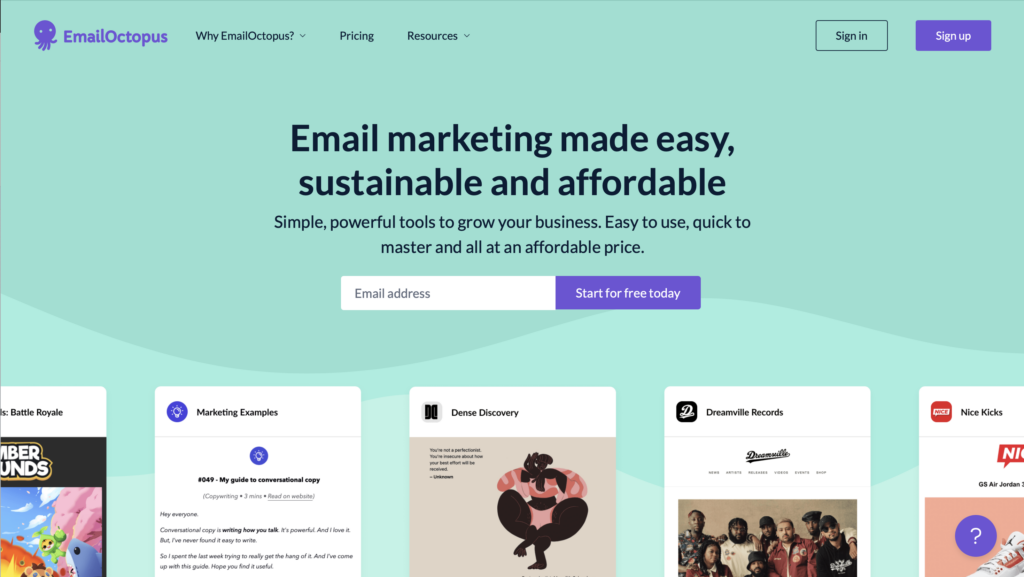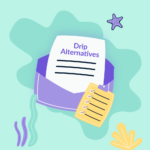Though many people consider Substack to be an email marketing tool, it’s actually a content distribution platform similar to Medium, with the added ability to send content via email. While Substack is excellent for distributing content, it falls short as an email marketing tool due to its lack of basic features like email automation.
Best Substack alternatives
Free tier comparison
| Tool | Free Tier (max subscribers) | Free Tier (max emails/mo.) |
|---|---|---|
| Substack | No capping | No capping |
| EmailOctopus | 2,500 | 10,000 |
| MailChimp | 500 | 1,000 |
| Mailerlite | 1,000 | 12,000 |
| Beehiiv | 2,500 | No capping |
| Campaign Monitor | Not available | Not available |
| ConvertKit | 1,000* * ConvertKit has a free plan option with higher limits that requires you to allow advertised recommendations – this is explained in more detail below | No capping |
| Constant Contact | Not available | Not available |
| Klaviyo | 250 | 500 |
| Drip | Not available | Not available |
Paid plan comparison
| Tool | Pricing/mo. (500 subscribers) | Pricing/mo. (10K subscribers) |
|---|---|---|
| Substack | N/A, takes 10% commission fees | N/A, takes 10% commission fees |
| EmailOctopus | $9 | $40 |
| MailChimp | Starts at $13 | Starts at $110 |
| Mailerlite | Starts at $10 | Starts at $73 |
| Beehiiv | Starts at $39 | Starts at $99 |
| Campaign Monitor | Starts at $12 | Starts at $109 |
| ConvertKit | Starts at $29 | Starts at $119 |
| Constant Contact | Starts at $12 | Starts at $120 |
| Klaviyo | Starts at $20 | Starts at $150 |
| Drip | $39 | $154 |
Pros & cons
| Tool | Pros | Cons |
|---|---|---|
| Substack | 1. Most features are free 2. Easy to use text editor 3. Hosted emails as blogs 4. Monetisation options | 1. Lack of automations and other essential features of email marketing 2. No option for custom domain (for sending emails) 3. No drag & drop email editor |
| EmailOctopus | 1. Easy to use 2. Very affordable (up to 70% less than alternatives) 3. No hidden costs. All features included | 1. Zapier integrations required for Ecommerce |
| MailChimp | 1. A/B testing 2. Inbuilt basic CRM 3. Mobile app | 1. Dashboard feels cluttered due to multiple feature addons 2. Regular price increases with no grandfathering |
| Mailerlite | 1. Inbuilt email validator 2. Feature rich landing page builder 3. Monetisation options 4. Ability to collect subscribers offline | 1. Has multiple plans which means that several features are not available in the basic plans 2. Landing page builder has a slight learning curve |
| Beehiiv | 1. Unlimited emails in all plans 2. Easy to use text editor 3. Hosted emails as blogs 4. Monetisation options | 1. Limited features for email marketing 2. Only has basic email automation |
| Campaign Monitor | 1. User friendly interface 2. Customisable designs | 1. Has multiple plans which means that several features are not available in the basic plans |
| ConvertKit | 1. Creator network (feature to let to cross-promote your newsletter) 2. Feature rich landing page builder 3. Monetisation options | 1. Focused towards creator economy, might not be the best choice for other domains/industries |
| Constant Contact | 1. Social media integration 2. Event management 3. AI assistance | 1. UI is cluttered due to several additional features 2. Some segmentation features only available on higher tiers |
| Klaviyo | 1. Native integration with ecommerce platforms 2. AI assistance for predictions, automation & content 3. A/B testing | 1. As Klaviyo is built for ecommerce, many of it’s features are not useful in general use cases 2. Pricing includes features like SMS and push notifications due to which you’ll be paying for features you might not use |
| Drip | 1. A/B testing 2. Large collection of email and form templates 3. Native integration with ecommerce platforms | 1. Drip is built for ecommerce so many of it’s features are not useful in general use cases 2. Users have reported Drip having a learning curve |
Best use case and ratings
| Tool | Best for | User Rating (data from GetApp) |
|---|---|---|
| Substack | Creators and writers | N/A |
| EmailOctopus | Small/medium businesses and newsletter writers | 4.7 |
| MailChimp | Startups and enterprises | 4.5 |
| Mailerlite | Small/medium businesses and startups | 4.7 |
| Beehiiv | Creators and writers | N/A |
| Campaign Monitor | Businesses that need advanced automations and personalisation | 4.6 |
| ConvertKit | Creators and writers | 4.7 |
| Constant Contact | Ecommerce and medium sized businesses | 4.3 |
| Klaviyo | Ecommerce and D2C businesses | 4.6 |
| Drip | Ecommerce businesses | 4.4 |
EmailOctopus
EmailOctopus focuses on providing an easy-to-use email marketing tool with all the essential features while keeping the prices affordable and transparent.

You get all the essential features like drag and drop email builder, no-code signup forms, automated emails and much more at a fraction of the cost versus alternatives.
Features:
- Easy to use drag and drop email builder
- List segmentation
- No-code signup, popup forms and landing pages
- Email automation
- Zapier and Make integrations
EmailOctopus is a popular Substack alternative that’s been used by over 80,000 businesses and individuals for their newsletters and email marketing activity.
Pricing:
Free for upto 2500 subscribers, with paid plans starting from $9/mo.
Mailchimp
Mailchimp is one of the most popular and well-known email marketing tools and has been for many years. They used to have a generous free plan of 12,000 emails to 2,000 subscribers per month and were known for their affordability. However, in 2023 they increased their prices three times and have reduced their free plan to a maximum of 1,000/month or 500/day with a 500 subscribers limit.
So, although Mailchimp remains a good email marketing platform, we’d recommend checking out all the other great alternatives to find the best fit for you.
Features:
- Email automation
- Segmentation
- Forms & landing Pages
- Dynamic content
- A/B testing
Pricing:
Has a free plan that’s good enough for testing, but not suitable for real life use cases. Paid plans start at $13/mo.
MailerLite
MailerLite is another popular email marketing platform, known for providing good tools at an affordable price. Despite a price increase in 2023, it’s still a great option if you need extra features like a comprehensive landing page builder.
Features:
- Easy to use drag and drop email builder
- List segmentation
- No-code signup and popup forms
- Extensive landing pages builder
- Email automation
- Zapier and Make integrations
MailerLite offers many additional features, like a native payment gateway and locked content. However, these extras can sometimes distract from the core service of email marketing. If you need these extra features and don’t mind paying a bit more, MailerLite could be a good choice.
Pricing:
A generous free plan exists, and paid plans start at $10/mo.
Beehiiv
Beehiiv is an email marketing and content platform built for creators and authors. It’s ideal for sending newsletters, but if you have broader email marketing needs, other tools may be better for you.
Features:
- Basic email editor
- List segmentation
- No-code hosted signup and popup forms
- Zapier integrations
Pricing:
Has a generous free plan and paid plans starts at $39/mo.
Campaign Monitor
Campaign Monitor is an email marketing tool that goes beyond marketing emails; it can also be used for SMS and transactional emails. Additionally, Campaign Monitor offers features like email personalisation, automation, and segmentation.
Features:
- Easy to use drag and drop email builder
- List segmentation
- A/B testing
- Loyalty & referral tool
- No-code signup and popup forms
- Extensive landing pages builder
- Email automation
- Zapier and Make integrations
Pricing:
Has no free tier and paid plans starts at $12/mo.
ConvertKit
ConvertKit is an email marketing tool focused on the creator economy, aiming to empower individual creators to build and monetise newsletters successfully. All its features are designed to help creators grow.
Features:
- Easy to use drag and drop email builder
- List segmentation
- Natively supports paid newsletters
- Extensive landing pages builder
- Email automation
- Zapier and Make integrations
- Monetise your newsletter with paid recommendations and ads
If you’re a creator, ConvertKit is an excellent choice. The only downside might be it’s pricing, especially if you’re not using all it’s premium features.
Pricing:
Has a generous free plan and paid plans starts at $29/mo.
Constant Contact
Constant Contact started off as an email marketing tool, but as of 2024, they have expanded into a full-fledged marketing communications platform. They now offer SMS marketing, social media marketing, and marketing automation.
Features:
- Email automation
- List segmentation
- Forms & landing pages
- Dynamic content
- A/B testing
- AI assistant
Constant Contact is a feature-rich tool, but it’s best if you need all its features. If not, a simpler email marketing tool like EmailOctopus might be a better fit.
Pricing:
No free plan exists, and paid plans start at $12/mo.
Klaviyo
Klaviyo is similar to Constant Contact but focuses on ecommerce and D2C businesses. In addition to email marketing, Klaviyo offers SMS marketing, push notifications, and product review management.
Features:
- Email automation
- List segmentation
- Forms & landing pages
- Dynamic content
- Native ecommerce integrations
- AI assistant
Klaviyo is a great choice if you are a D2C brand and have the budget. However, there are many other tools that can get the job done at a fraction of the cost.
Pricing:
Has a free plan that’s good enough for testing, but not suitable for real life use cases. Paid plans start at $20/mo. which also includes SMS and push notification credits.
Drip
Drip started as a popup tool and has evolved into an email marketing platform. It’s designed to integrate seamlessly with Shopify and includes all the features needed to scale your ecommerce business.
Features:
- Email automation
- List segmentation
- Large popup template collection
- Dynamic content
- A/B testing
Pricing:
Has no free tier, and paid plans start at $39/mo.
Frequently asked question
What is the downside of Substack?
While Substack is popular for its user-friendly platform and monetisation options for writers, there are some downsides to consider:
- Revenue dependence on subscribers: Your income on Substack largely depends on the number of paying subscribers you can attract and retain. If subscriptions drop, so does your revenue.
- Limited customisation: Substack offers limited customisation options compared to other platforms, which can be restricting if you want more control over the design and functionality of your newsletter.
- Email deliverability issues: Some users have reported issues with emails not being delivered to subscribers’ inboxes, which can affect engagement and the overall reach of your content.
- Fee structure: Substack takes a 10% commission on your subscription revenue, in addition to payment processing fees. This can add up, especially for writers with large subscriber bases.
- Lack of discovery features: The platform has limited tools for new readers to discover your newsletter, making it difficult to grow your audience organically.
- Content ownership concerns: While you own your content, Substack’s terms may not fully protect your interests in certain scenarios, such as platform changes or contract adjustments.
- Competition and saturation: As Substack grows, more writers are flocking to the platform, increasing competition and potentially making it harder to stand out.
These factors can vary in importance depending on your specific needs and goals as a writer.
Can EmailOctopus replace Substack?
At first glance, both may look like email marketing tools, but in reality, there are differences.
EmailOctopus is primarily an email marketing platform — focusing on sending marketing emails, automating email activity, managing email lists, and providing campaign analytics. It’s designed to help businesses and individuals manage their email marketing efforts efficiently and grow.
Substack, on the other hand, is designed for content creators who want to publish blogs and newsletters and charge subscribers for access. It combines content distribution with email delivery, allowing writers to monetise their newsletters directly.
Is Substack free?
Most of Substack’s features and functionalities are free and available for everyone. However, there are some costs to consider:
- Custom domain fee: There’s a $50 one-time charge for setting up a custom domain (e.g. yourdomain.com).
- Revenue split: Substack takes a 10% commission on your subscription revenue from paid newsletters, in addition to payment processing fees.


No Comments
Leave a comment Cancel